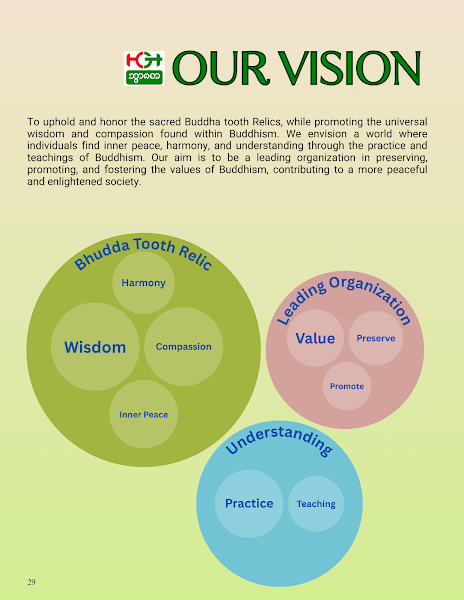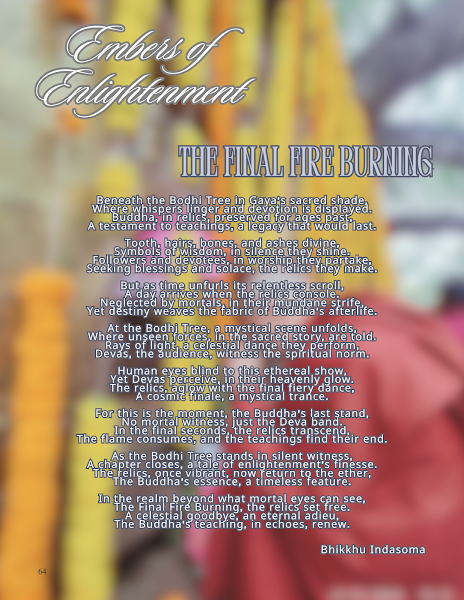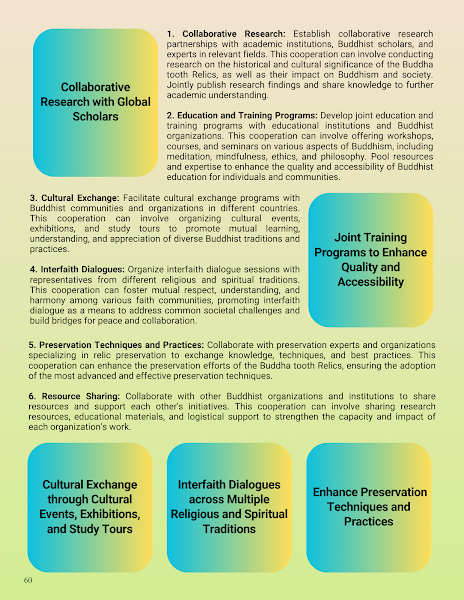Vandāmi bhante sabbaṃ aparādhaṃ khamatha me bhante mayhā kataṃ puññaṃ sāmināanumoditabbaṃ sāminā kataṃ puññaṃ mayhaṃ dātabbaṃ sādhu sādhu anumodāmivandāmi bhante.
ဝန္ဒာမိ
Acknowledgment and Respect
Bhikkhuni Sangha and the Construction of Religious Monuments (Inscription of Bhikkhuni Dhammarakkhita)
Throughout the long history of Buddhism, the Bhikkhuni Sangha (community of ordained Buddhist nuns) appears to have had only a minor role. They were not invited to participate in the Buddhist Councils (Saṅgāyana), and even during Emperor Ashoka's time, when he sent out nine missionary delegations, no Bhikkhuni was included. This may be due to the difficulties and dangers that women faced when traveling long distances, making it impractical for them to join such missions. As a result, the Bhikkhuni Sangha did not spread widely, and it appears that their role gradually diminished after the Buddha's parinibbāna (passing away). Some scholars have even claimed that the Bhikkhuni Sangha may have disappeared around 600 BE (43 BCE).
However, archaeological evidence from inscriptions at important Buddhist sites suggests otherwise. Even during the Pāla dynasty period (circa 1300–1600 BE / 757–1057 CE), the names of Bhikkhunis can still be found, implying that the Bhikkhuni Sangha continued to exist, albeit with limited influence. It is likely that Bhikkhunis remained active until the final decline of Buddhism in India, around 1700 BE (1157 CE).
The Bharhut Inscription
One of the most significant pieces of evidence is found at Bharhut Stupa, built during the Shunga Dynasty, around 300 BE (circa 227 BCE). Inscriptions from this site, written in Brāhmī script and Prakrit language, record the names of Bhikkhunis from various cities who donated to the construction of different parts of the stupa. In total, at least ten Bhikkhunis are named as sponsors of various structures, including pillars, gateways (toranas), stupa walls, and other surrounding elements.
One Bhikkhuni in particular is recorded as the donor of a railing pillar surrounding the stupa. The inscription, written in three lines, reads:
-
Kosapekaye (Kosambīkaye) Bhikkhunīye
-
Venuginiyāye Dhamarakhitā
-
Yā (Dhammarakkhitāya) dānaṁ
Translation:
"The donation of the Bhikkhuni named Dhammarakkhita, from the Venuginīya clan, a native of Kosambī."
This indicates that the donor of the pillar was a Bhikkhuni named Dhammarakkhita (Pāli) or Dharmarakṣitā (Sanskrit). She belonged to the Venuginīya family and hailed from the city of Kosambī.
This evidence confirms that Bhikkhunis not only existed during that period but also took part in significant religious acts, such as sponsoring major parts of a stupa's construction—an indication of their religious commitment, status, and merit.
Language Evolution in Inscriptions
During the Maurya, Shunga, and Kushan periods (approx. 200–750 BE / 343 BCE–207 CE), donor inscriptions typically began with the word “dānaṁ” meaning “gift” or “offering.” However, in the later Gupta and Pāla periods (approx. 1000–1600 BE / 543–1057 CE), where Sanskrit became more dominant, inscriptions began using the term “deyyadharma”, which also means religious offering or pious gift.
Ancient inscriptions like the one at Bharhut provide not only architectural and artistic insights but also highlight the often-overlooked role of Bhikkhuni Sangha in the support and development of the Buddhist religion. Though historical records may be sparse, these stone inscriptions are silent yet powerful testimonies to the contributions and devotion of Buddhist nuns.
The story of Bhikkhuni Dhammarakkhita stands as concrete evidence of female monastics’ presence and religious involvement, demonstrating that women played an essential part in the early propagation and establishment of Buddhism—even if their voices were not always recorded in mainstream historical texts.
“Though quiet in the pages of history, the faith of the Bhikkhuni resounds in the stone inscriptions.”
The Dream of the Sacred Relics : The Scholar's Discovery of the Dreamt Coil
Inscribed Vase from Bajaur
Discovery & Provenance
Discovered in 1833 CE (2376 BE) by Charles Masson, a British explorer, during his excavations in the Swat Valley, Pakistan. The vase was found among ruins in Bajaur, a small but historically significant Buddhist site.
Inscription Details
Material: Polished clay vase with a Kharoṣṭhī inscription encircling its body.
Language: Prakrit (with some Sanskrit influence).
Script: Kharoṣṭhī (typical of Gandharan Buddhist inscriptions).
Date: ~60–160 CE (600–700 BE), based on paleography and historical context.
Inscription Text & Translation
Original (Kharoṣṭhī Script):
(Transcribed from Kharoṣṭhī to Roman script for readability)
𐨯𐨎𐨬𐨟𐨿𐨯𐨪𐨀𐨅 𐨟𐨿𐨪𐨅𐨮𐨛𐨁𐨨𐨀𐨅 𐩅 𐩅 𐩅 𐩀 𐩀 𐩀 𐨨𐨱𐨪𐨩𐨯 𐨀𐨩𐨯 𐨀𐨟𐨁𐨡𐨯 𐨐𐨪𐨿𐨟𐨁𐨀𐨯 𐨨𐨯𐨯 𐨡𐨁𐨬𐨯𐨀𐨅 𐨮𐨆𐨜𐨭𐨀𐨅 𐨀𐨁𐨨𐨅𐨞 𐨕𐨅𐨟𐨿𐨪𐨁𐨐 𐨐𐨿𐨮𐨞 𐨀𐨁𐨡𐨿𐨪𐨬𐨪𐨿𐨨𐨅 𐨐𐨂𐨨𐨪𐨅 𐨀𐨤𐨿𐨪𐨕𐨪𐨗𐨤𐨂𐨟𐨿𐨪𐨅
Saṃvatsare trisatime 20 20 20 1 1 1 mahārāyasa ayasa atidasa karatiasa māsasa divase ṣoḍaśe imena cetrika kṣaṇa Indravarme kumāre Apracarājaputre𐨀𐨁𐨨𐨅 𐨧𐨒𐨬𐨟𐨆 𐨭𐨐𐨿𐨩𐨨𐨂𐨞𐨁𐨯 𐨭𐨪𐨁𐨪 𐨤𐨿𐨪𐨡𐨁𐨛𐨬𐨅𐨟𐨁 𐨛𐨁𐨀𐨀𐨅 𐨒𐨧𐨁𐨪𐨀𐨅 𐨀𐨤𐨿𐨪𐨡𐨁𐨛𐨬𐨁𐨟𐨤𐨿𐨪𐨬𐨅 𐨤𐨟𐨅𐨭𐨅 𐨦𐨿𐨪𐨨𐨿𐨨𐨤𐨂𐨙𐨆 𐨤𐨿𐨪𐨯𐨬𐨟𐨁 𐨯𐨢 𐨨𐨡𐨂𐨞 𐨪𐨂𐨑𐨂𐨞𐨐𐨀 𐨗𐨁𐨤𐨂𐨟𐨿𐨪𐨀𐨅 𐨀𐨤𐨿𐨪𐨕𐨪𐨗𐨧𐨪𐨿𐨩𐨀𐨅
ime bhagavato Śākyamuniś śarīra pratiṣṭhaveti ṣṭhite gambhīre aparapratiṣṭhitaprave padeśe brāhmaṇapuṇyo prasavati saha madhuna Rukhunakā jiputre Apracarājabharye𐨯𐨢 𐨨𐨀𐨂𐨫𐨅𐨞 𐨪𐨨𐨐𐨅𐨞 𐨯𐨢 𐨨𐨀𐨂𐨫𐨞𐨁𐨀𐨅 𐨡𐨮𐨐𐨀𐨅 𐨯𐨢 𐨭𐨿𐨤𐨯𐨡𐨪𐨅𐨱𐨁 𐨬𐨯𐨬𐨡𐨟𐨀𐨅 𐨨𐨱𐨬𐨅𐨡𐨀𐨅 𐨞𐨁𐨐𐨀𐨅 𐨕 𐨒𐨱𐨁𐨞𐨁𐨀𐨅 𐨩 𐨀𐨂𐨟𐨪𐨀𐨅
saha mātuleṇa Rāmakeṇa saha mātulaṇiye Daśake saha śvaśruhi Vasavadattā mahādevā Nikā ca gṛhiṇī yā Uttarā𐨟𐨂 𐨀 𐨤𐨂𐨩𐨀𐨅 𐨬𐨁𐨮𐨸𐨂𐨬𐨪𐨿𐨨𐨯 𐨀𐨬𐨕𐨪𐨩𐨯
pitṛ a pūye Viṣṇuvarmasa avacarayasa𐨪𐨡 𐨬𐨒 𐨯𐨿𐨟𐨿𐨪𐨟𐨅𐨒𐨆 𐨤𐨂𐨩𐨀𐨁𐨟𐨅 𐨬𐨁𐨗𐨩𐨨𐨁𐨟𐨿𐨪𐨆 𐨩 𐨀𐨬𐨕𐨪𐨩 𐨨𐨡𐨂𐨭𐨿𐨤𐨯 𐨧𐨀𐨁𐨡𐨟 𐨤𐨂𐨩𐨁𐨟
bhrātā vaga stratage pūyite Vijayamitro ya avacaraya madhuśvasā Bhaidatā pūyitā𐨀𐨁𐨨𐨅 𐨕 𐨭𐨪𐨁𐨪𐨅 𐨨𐨂𐨪𐨿𐨩𐨐𐨫𐨁𐨞𐨟𐨅 𐨠𐨂𐨦𐨂𐨟𐨅 𐨐𐨁𐨜𐨤𐨜𐨁𐨱𐨪𐨁𐨀 𐨀𐨵𐨁𐨩𐨅 𐨀𐨱𐨅𐨛𐨁 𐨨𐨗𐨁𐨨𐨨𐨁 𐨤𐨿𐨪𐨟𐨁𐨛𐨬𐨞𐨨𐨁 𐨤𐨿𐨪𐨟𐨁𐨛𐨬𐨁𐨯
ime ca śarīre Mūryakaliṇate sthūbute kiṭapiḍihare avahiye aheṭhi majimmi pratiṣṭhāvaṇami pratiṣṭhāvisa𐨬𐨯𐨁𐨀 𐨤𐨎𐨕𐨀𐨁𐨭𐨆
vaśiṣṭha pañcaiśo
Translation:
*"In the 63rd year (of the Azes era), on the 16th day of the month of Kārttika, during an auspicious moment, Prince Indravarman, son of King Apraca, enshrined the relics of the Blessed Śākyamuni Buddha in a deep and secure stupa. He performed this meritorious act alongside:
His mother, Queen Rukhunakā (daughter of King Aji),
His uncle, Rāmaka,
His aunt, Daśakā,
His wife, Vasavadattā,
The noblewoman Mahādevā,
The householder Nikā,
And Uttarā.
This act is also dedicated to:
His father, Viṣṇuvarman,
His brother, Vijayamitra (king of Apraca),
His maternal aunt, Bhaidattā.
These relics are housed in a stupa built by the Mauryas, stored securely in a deep and protected chamber."*
Historical Significance
Confirms the Apraca Dynasty’s Rule:
The inscription mentions King Apraca and his son Indravarman, rulers of a local kingdom in Gandhara.
Mauryan Connection:
Refers to the stupa’s construction by the Mauryas, suggesting an earlier foundation later reused by the Apraca kings.
Buddhist Patronage:
Shows the royal family’s devotion to Buddhism, enshrining relics with elaborate rituals.
Dated to the Azes Era:
The "Year 63" likely refers to the Azes era (starting ~47 BCE), placing this inscription around 16 CE (600 BE).
Current Location
The vase is displayed at the Metropolitan Museum of Art, New York, USA.
Why This Matters
Rare Evidence: One of few inscriptions detailing the Apraca dynasty’s Buddhist patronage.
Cultural Blend: Mixes Indian (Kharoṣṭhī/Prakrit), Greek (Azes era), and Central Asian influences.
Artifact of Looting: Like many Gandharan relics, it reached Western museums via 19th-century colonial collections.
Research Note: The term "Mūrya" (Maurya) is intriguing—was this stupa originally Mauryan, or does it refer to a later guild of builders?
The Final Fire Burning
 THE FINAL FIRE BURNINGBeneath the Bodhi Tree in Gaya's sacred shade,Where whispers linger and devotion is displayed,Buddha, in relics, preserved for ages past,A testament to teachings, a legacy that would last.
THE FINAL FIRE BURNINGBeneath the Bodhi Tree in Gaya's sacred shade,Where whispers linger and devotion is displayed,Buddha, in relics, preserved for ages past,A testament to teachings, a legacy that would last.Tooth, hairs, bones, and ashes divine,Symbols of wisdom, in silence they shine.Followers and devotees, in worship they partake,Seeking blessings and solace, the relics they make.
But as time unfurls its relentless scroll,A day arrives when the relics console.Neglected by mortals, in their mundane strife,Yet destiny weaves the fabric of Buddha's afterlife.
At the Bodhi Tree, a mystical scene unfolds,Where unseen forces, in the sacred story, are told.Rays of light, a celestial dance they perform,Devas, the audience, witness the spiritual norm.
Human eyes blind to this ethereal show,Yet Devas perceive, in their heavenly glow.The relics, aglow with the final fiery dance,A cosmic finale, a mystical trance.
For this is the moment, the Buddha's last stand,No mortal witness, just the Deva band.In the final seconds, the relics transcend,The flame consumes, and the teachings find their end.
As the Bodhi Tree stands in silent witness,A chapter closes, a tale of enlightenment's finesse.The relics, once vibrant, now return to the ether,The Buddha's essence, a timeless feature.
In the realm beyond what mortal eyes can see,The Final Fire Burning, the relics set free.A celestial goodbye, an eternal adieu,The Buddha's teaching, in echoes, renew.Bhikkhu Indasoma
References
Bodhi, B. (Trans.). (1995). The Mahāparinibbāna Sutta (DN 16). In The Long Discourses of the Buddha: A Translation of the Dīgha Nikāya (pp. 231–277). Boston, MA: Wisdom Publications.
Bodhi, B. (Trans.). (1995). The Four Noble Places of Pilgrimage (Cullavagga X). In The Connected Discourses of the Buddha: A Translation of the Saṃyutta Nikāya (pp. 1675–1680). Boston, MA: Wisdom Publications.
Ñāṇamoli, B., & Bodhi, B. (Trans.). (1995). The Doctrine of Impermanence (Dhammapada, vv. 277–279). In The Path of Purification (pp. 10–11). Seattle, WA: Pariyatti Publishing.
Rhys Davids, T. W., & Oldenberg, H. (Trans.). (1881). The Symbolism of the Relics (Cullavagga X). In Vinaya Texts: The Mahāvagga, Part I and II. Oxford, UK: Clarendon Press.
Thanissaro Bhikkhu. (Trans.). (1997). The Teaching of Striving Diligently (AN 4.180). Retrieved from https://www.accesstoinsight.org.
Walshe, M. (Trans.). (1987). The Rays of Light at Enlightenment (Suttanipāta, vv. 684). In The Long Discourses of the Buddha: A Translation of the Dīgha Nikāya. Boston, MA: Wisdom Publications.
"The Teaching of Six Consciousnesses and Their Cessation" (Chaviññāṇa Nirodha Desanā)
Ekāhaṃ jīvitaṃ seyyo, passato udayabbayaṃ"
Translation of the Pali terms:
- Yo ca: Any person, whether monk or layperson
- Udayabbayaṃ: The arising and passing away of the five aggregates (mind-matter phenomena)
- Apassaṃ apassanto: One who does not see or contemplate
- Vassasataṃ: One hundred years
- Jīve: Lives
- Na seyyo: Is not worthy
If one doesn't understand the five aggregates and impermanence, is there any value in being human? Is there any worth in living for a hundred years? Would there even be value in living for 84,000 eons?
- Udayabbayaṃ: The arising and passing away of the five aggregates
- Passanto: One who sees and contemplates
- Ekāhaṃ: One day
- Jīve: Lives
- Seyyo: Is superior/more worthy
Even living for one hour with true seeing is worthy. Even half an hour is worthy. Even one minute is worthy. Isn't this worth examining? These are the essential points. Don't look too far ahead. Isn't it taught as "mere seeing" because of the seeing-knowing mind?
It's like clear water in a vessel. When the water is clear, can't you see everything inside? Then if you add dye - whether green, blue, or red - doesn't it become murky? Can you still see? Can you still see your reflection? No, you can't. Therefore, "mere seeing, mere hearing" is taught as being protected by mindfulness, wisdom, and knowledge, like a protective barrier or fortress of wisdom.
"Consider what Ledi Sayadaw teaches: Isn't it taught that eye-consciousness (cakkhuviññāṇa) is impermanent - it arises and passes away? Isn't it taught that ear-consciousness (sotaviññāṇa) arises and passes away after hearing? Isn't it taught that nose-consciousness (ghānaviññāṇa) arises and passes away after smelling?
Isn't it taught that tongue-consciousness (jivhāviññāṇa) passes away after tasting? Isn't it taught that body-consciousness (kāyaviññāṇa) passes away after touching? Isn't it taught that mind-consciousness (manoviññāṇa) passes away after thinking? Indeed, there is nothing but arising and passing away.
Isn't seeing taught as arising? After seeing, doesn't it pass away? When one sees this, isn't it called mindfulness? When mindfulness is present in seeing, and in the remaining six sense doors, doesn't one see impermanence? Isn't it taught to stop at seeing? One sees only impermanence. One sees the five aggregates and sees impermanence.
When impermanence is seen, does craving still arise? When truth is known, doesn't falsehood disappear? Isn't the characteristic of impermanence taught as the truth of suffering? Do greed, hatred, and delusion still arise? This is why the teachings to Mālukyaputta and Bāhiya are given.
The work of stream-entry, once-returning, non-returning, and arahantship was completed. How inspiring it is! While on alms round, in such a short time - going to request teachings from the Buddha during alms round.
When the monastic duties were completed, he had no robes. He couldn't remain long in human form - only seven days were permitted. After seven days, the burden of aggregates had to be laid down. If one wanted to stay longer, wouldn't one need to change clothes?
In that era, there weren't even people selling robes. Paṃsukūla robes were made from discarded cloth from village rubbish heaps - worn sarongs, shirts, and longyi. These had to be collected, washed, the firm parts cut away, and sewn together. That's how robes were made by piecing together patches.
Robes were that scarce. When he left, due to past grudge, a yakkhini (demon) disguised as a cow gored him to death. There, Bāhiya attained parinibbāna. When the monks returned from alms round, they saw him dead in the rubbish heap.
Didn't they report this to the Buddha? Bāhiya has died? The Buddha said, "He's not dead - he has attained parinibbāna." Didn't he instruct them to cremate the body? When they cremated him, relics remained. Isn't this worth contemplating? Study it this way..."
1. Eye-consciousness (cakkhuviññāṇa) - seeing and passing away
2. Ear-consciousness (sotaviññāṇa) - hearing and passing away
3. Nose-consciousness (ghānaviññāṇa) - smelling and passing away
4. Tongue-consciousness (jivhāviññāṇa) - tasting and passing away
5. Body-consciousness (kāyaviññāṇa) - touching and passing away
6. Mind-consciousness (manoviññāṇa) - thinking and passing away
The key points:
- There is nothing but arising and passing away
- When seeing occurs, it arises and passes away
- Mindfulness (sati) is recognizing this process
- When mindfulness is established in all six sense-doors, impermanence becomes clear
- When one sees impermanence, craving (taṇhā) cannot arise
- When truth is known, delusion disappears
- The characteristic of impermanence reveals the truth of suffering (dukkha)











































